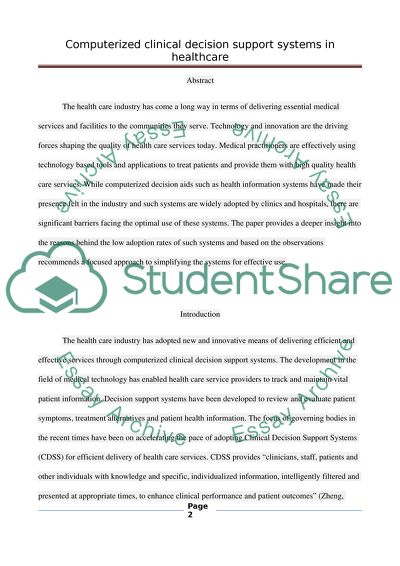Cite this document
(Computerized Clinical Decision Support Systems in Healthcare - Pros, Cons, and Liabilities Literature review Example | Topics and Well Written Essays - 2000 words - 1, n.d.)
Computerized Clinical Decision Support Systems in Healthcare - Pros, Cons, and Liabilities Literature review Example | Topics and Well Written Essays - 2000 words - 1. https://studentshare.org/information-technology/1784259-computerized-clinical-decision-support-systems-in-healthcare-pros-cons-liabilities
Computerized Clinical Decision Support Systems in Healthcare - Pros, Cons, and Liabilities Literature review Example | Topics and Well Written Essays - 2000 words - 1. https://studentshare.org/information-technology/1784259-computerized-clinical-decision-support-systems-in-healthcare-pros-cons-liabilities
(Computerized Clinical Decision Support Systems in Healthcare - Pros, Cons, and Liabilities Literature Review Example | Topics and Well Written Essays - 2000 Words - 1)
Computerized Clinical Decision Support Systems in Healthcare - Pros, Cons, and Liabilities Literature Review Example | Topics and Well Written Essays - 2000 Words - 1. https://studentshare.org/information-technology/1784259-computerized-clinical-decision-support-systems-in-healthcare-pros-cons-liabilities.
Computerized Clinical Decision Support Systems in Healthcare - Pros, Cons, and Liabilities Literature Review Example | Topics and Well Written Essays - 2000 Words - 1. https://studentshare.org/information-technology/1784259-computerized-clinical-decision-support-systems-in-healthcare-pros-cons-liabilities.
“Computerized Clinical Decision Support Systems in Healthcare - Pros, Cons, and Liabilities Literature Review Example | Topics and Well Written Essays - 2000 Words - 1”. https://studentshare.org/information-technology/1784259-computerized-clinical-decision-support-systems-in-healthcare-pros-cons-liabilities.


